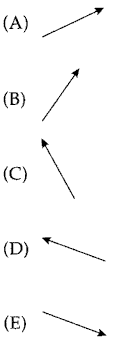1.
An object that’s moving with constant speed travels once around a circular
path. Which of the following is/are true concerning this motion?
I. The displacement is zero.
IL The average speed is zero.
III. The acceleration is zero.
(A) I only
(B) I and II only
(C) I and III only
(D) III only
(E) II and III only
2.
At time t = t1, an object’s velocity is given by the vector v1
shown below:

A short time later, at t = t2, the object’s velocity is the
vector v2:

If || v2 || = || v1 || , which one of the following
vectors best illustrates the object’s average acceleration between t = t1
and t = t2?

3.
Which of the following is/are true?
I. If an object’s acceleration is constant, then it must move in a
straight line.
II. If an object’s acceleration is zero, then its speed must remain
constant.
III. If an object’s speed remains constant, then its acceleration must be
zero.
(A) I and II only
(B) I and III only
(C) II only
(D) III only
(E) II and III only
4.
4. A baseball is thrown straight upward. What is the ball’s acceleration at
its highest point?
(A)0
(B) ½g, downward
(C) g, downward
(D) ½g, upward
(E) g, upward
5.
How long would it take a car, starting from rest and accelerating uniformly
in a straight line at 5 m/s2, to cover a distance of 200 m?
(A) 9.0 s
(B) 10.5 s
(C) 12.0 s
(D) 15.5 s
(E) 20.0 s
6.
6. A rock is dropped off a cliff and strikes the ground with an impact
velocity of 30 m/s. How high was the cliff?
(A) 15 m
(B) 20 m
(C) 30 m
(D) 45 m
(E) 60 m
7.
A stone is thrown horizontally with an initial speed of 10 m/s from a
bridge. If air resistance could be ignored, how long would it take the stone
to strike the water 80 m below the bridge?
(A) 1 s
(B) 2 s
(C) 4 s
(D) 6 s
(F) 8 s
8.
A soccer ball, at rest on the ground, is kicked with an initial velocity of
10 m/s at a launch angle of 30°. Calculate its total flight time, assuming
that air resistance is negligible.
(A) 0.5 s
(B) 1 s
(C) 1.7 s
(D) 2 s
(E) 4 s
9.
A stone is thrown horizontally with an initial speed of 30 m/s from a
bridge. Find the stone’s total speed when it enters the water 4 seconds
later. (Ignore air resistance.)
(A) 30 m/s
(B) 40 m/s
(C) 50 m/s
(D) 60 m/s
(E) 70 m/s
10.
Which one of the following statements is true concerning the motion of an
ideal projectile launched at an angle of 45° to the horizontal?
(A) The acceleration vector points opposite to the velocity vector on
the way up and in the same direction as the velocity vector on the way
down.
(B) The speed at the top of the trajectory is zero.
(C) The object’s total speed remains constant during the entire flight.
(D) The horizontal speed decreases on the way up and increases on the
way down.
(E) The vertical speed decreases on the way up and increases on the way
down.

